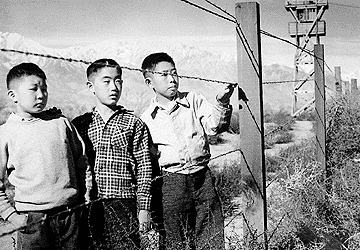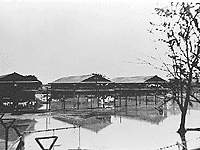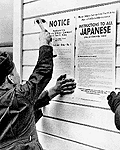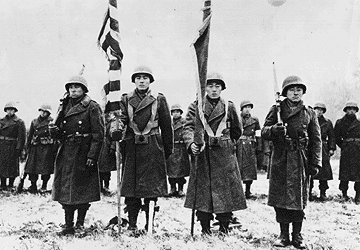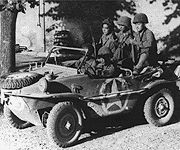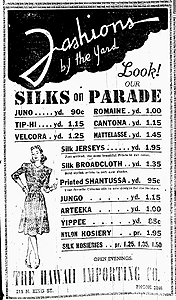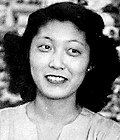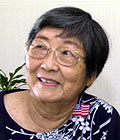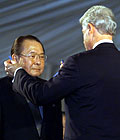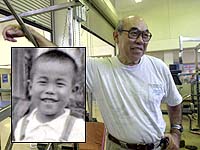 |

|
Story by Dan Nakaso Betty Dietz's family burned an attic full of Japanese dolls. Irwin Kunishima's boyhood friends suddenly began taking him prisoner whenever they played Army and told him it was "bad" to want to be a Japanese soldier. And in the moments after the attack on Pearl Harbor, a McKinley High School boy named Dan Inouye looked toward the sky and yelled, "You dirty Japs!" The attack that launched America into World War II changed an entire generation of Japanese Americans in Hawai'i and on the Mainland and forced them to reshape their attitudes toward both their heritage and the country they called home. Today, Japanese American leaders stand side by side with Arabs and Muslims who are feeling the sting of racism and hatred after another attack on U.S. soil. The fact that Japanese American civic and government leaders can even speak on the national stage at all is a testament to how far a generation of Japanese Americans have come after fighting racism in war and at home, where 120,000 were forced into internment camps. First, they had to sacrifice much of the Japanese side of their heritage. Second-generation Nisei and their sansei sons and daughters were probably destined to become more Westernized than their issei, or first-generation, predecessors, scholars say. But the attack on Pearl Harbor caused Japanese Americans to discard the Japanese side of their roots with remarkable speed. "We tried as much as possible to shed our culture, and as the years passed, we stepped farther and farther away from our culture," said John Tateishi, the national executive director of the Japanese American Citizens League, who spent three years at the Manzanar camp in California's Owens Valley. "I don't think any of us had parents telling us, 'You must be more American so this doesn't happen again.' They didn't have to. The more Japanese you were, the more crap you had to endure, the more harassment or insults or physical abuse you had to take from your white friends, who would mock us, make fun of us, insult us. It was such a discomforting thing that ultimately you learned to be as American as possible."
"During the war, everything Japanese was supposed to be bad," said Jane Komeiji, who was a 16-year-old schoolgirl living across from A'ala Park at the time of the attack. "It was no good. It was old-fashioned. We were told to discard everything." Despite sometimes frightening anti-Japanese sentiment, Japanese Americans in Hawai'i clung to their culture much more tightly than those on the Mainland. That was the result of two factors: the lack of widespread internment in Hawai'i and sheer numbers. "The major difference was probably the size of the population — 40 percent here compared to 1.4 percent in California," said Jon Okamura, an assistant professor of ethnic studies at the University of Hawai'i, who teaches a course on the Japanese in Hawai'i. "Japanese Americans were still called 'Jap' here. But their numbers and the concentrations of communities and plantation areas gave them a stronger basis to resist." During the war, Japanese Americans represented 25 percent of the territorial voting bloc but failed to wield any force, Okamura said. In the 1942 and 1944 elections, only one Japanese American ran for office. He won. Then the boys came home from the war, and what happened next has become the stuff of legend in Hawai'i: A generation of Nisei soldiers from the 442nd Regimental Combat Team, 100th Battalion and Military Intelligence Service returned to Hawai'i, often becoming the first in their families to go to college, courtesy of the GI Bill. They still encountered racism. But they sometimes turned it into a counter-punch to highlight their patriotism during the war. At a Democratic rally in 1954, wounded war hero Inouye stopped a group of Republican dissidents who were implying that Democrats were soft on communism.
"I held up my empty right sleeve and shook it," wrote Inouye, who lost his arm to a German grenade launcher while taking out a machine-gun nest. "'I gave this arm to fight fascists. If my country wants the other one to fight communists, it can have it." Inouye, now the senior U.S. senator from Hawai'i, became part of a Democratic Party revolution that changed the course of Hawai'i history. "If it hadn't been for the war," Okamura said, "it would have taken a much longer time for the AJAs (Americans of Japanese ancestry) to attain socio-economic mobility. That movement came with the assistance of the college-educated Nisei." On the Mainland, Japanese Americans were sometimes pointed out as a "model minority" that had learned to assimilate into American culture. "The war taught us how to survive in this country and how to get into the seats of power," Tateishi said. "We had to figure out a lot of things along the way, even though it's not part of our culture to stand out and run for elected offices." Like other immigrant groups, each generation of Japanese Americans would have become more Westernized over time, Tateishi said. But the attack on Pearl Harbor clearly speeded up the process. "We would have stayed in our own ghettos," he said. "We would have found comfort in being as Japanese as we could. We would have retained much more of the uniqueness of who we were." Today, the remnants of the dramatic changes in Japanese American culture can be seen in the interracial marriages thriving here and on the Mainland, Tateishi said. "In the past, it was only Japanese American girls marrying whites," he said. "Today, the real change is the Japanese American men marrying non-Japanese American women. "We're seen as acceptable now," he said. "Not only acceptable, but desirable."
By Dan Nakaso
"I hurt so bad for so many years," she said. "I didn't know that the war had such a trauma on my life. When I saw that movie, I cried. That's how fresh the pain was inside of me." Dietz left Hawai'i after graduating from Farrington High School and barely glanced back at the Islands. She's 64 now and lives in Orange County, Calif., in a Westminster neighborhood with only a couple of Japanese American families. She married a Caucasian man from Kansas City and only recently realized how she had been shaped by her Japanese upbringing and racism from the war. She has been attending a 12-step program for co-dependents, which ended up unlocking the feelings that she links to the attack, which happened in the weeks before Christmas 1941. "If I had not gone to those meetings," she said, "I wouldn't have understood why Christmas was always such a hard time in my life. For years, I had nightmares whenever I heard airplanes flying over head. The attack was, very, very much a part of me." Dietz grew up the fifth of eight children in Kalihi Valley with Dietz' grandmother, uncle and his family. Her father and uncle owned Oda Brothers Machine Shop in Kalihi. Her mother took care of the house and her aunt and grandmother sold vegetables and flowers. The was no such thing as power sharing in the household, Dietz said. Her father ruled and liked it that way, she said. "I didn't like the way my father treated my mother, the 'one up, one down' way that is very, very strong in the Asian culture," she said. "It doesn't respect how strong women are. As a result, I was very insecure most of my life." The war years didn't help. She was only 4 when the Japanese attacked Pearl Harbor, but the memories are clear and painful. Schoolchildren spat on Dietz and her brothers and sisters on their way to school and called them "Japs." Other children wore name tags to distance themselves from the Nisei children of Japanese immigrants — name tags that read: "I am Chinese" or "I am Korean." After high school, Dietz planned to go to college on the Mainland for three years and return to Hawai'i. She ended up staying in California. In 1999, still wrestling with insecurity, Dietz joined a friend at Toastmasters in Orange County. She decided it was her chance to tell her story. She spoke about the quiet Sunday morning in December when the Japanese attacked. She talked of the humiliation as soldiers searched their bedrooms. "They proceeded to walk upstairs in their shoes," she told the Toastmasters crowd. "This was a total disrespect in my culture as our shoes were always left at the entrance of our home. … They broke my brother's shortwave radio and took my uncle's camera. They treated us as though we were the enemy." The speech allowed Dietz to overcome one of her greatest fears of speaking in front of a crowd of strangers. More importantly, she said, "It helped me process a lot of pain." Today Dietz works as a massage therapist and prefers to hold on to the painful memories of her life, even of Dec. 7, 1941. "Some people say there's nothing good to remember about the attack," Dietz said. "I treasure that day because it had a big part in making me who I am. And I'm better as a result of it."
By Dan Nakaso The Japanese American soldiers of the 442nd Regimental Combat Team were thrown together as a segregated unit to fight the enemy. But first they had to battle their own bigotry. Fistfights broke out every few days. Stink eye was everywhere in the barracks at Camp Shelby, Miss., where the soldiers were training for war after the Japanese attack on Pearl Harbor. They may have been part of an all-Japanese American, segregated unit, but the boys from Hawai'i and the Mainland Japanese Americans, or "katonks," were so divided that the officers considered breaking up the regiment before they even went into battle. And if that had happened, the 442nd would never have gone on to become the most-decorated unit for its size in American history, whose soldiers received the Medal of Honor, Distinguished Service Cross, Silver Star, Bronze Star and more than 9,000 Purple Hearts. Even an outsider could tell the difference between the boys from Hawai'i and the ones from big cities on the Mainland, said Sen. Dan Inouye (D-Hawai'i), who started as a soldier with the 442nd and ended up a highly decorated captain and one of the outfit's most famous veterans. The Hawai'i soldiers were darker and more unkempt, Inouye said. The katonks constantly snickered at the Hawai'i soldiers' pidgin English. "The Japanese from the Mainland spoke a much more refined and cultured English than the ones in Hawai'i," he said. The Hawai'i soldiers scornfully claimed that if any of the Mainlanders got struck on the head, there always would be a hollow sound — "ka-tonk!" The officers regularly held discussion groups. And that kept things quiet for a day or two. "Sooner or later, you'd be throwing blows," Inouye said. Finally, in the summer of 1943, some of the soldiers received invitations to spend the weekend dancing and partying at a place called Rohwer, Ark. "We were told we have a weekend of fun and festivity," Inouye said. "We thought we'd go to a community where there would be a lot of Japanese there." It wasn't until much later that Inouye realized that all of the soldiers he knew who had been invited were from Hawai'i. They were too busy showering, shaving and pressing their uniforms to notice. On the nearly four-hour trip from Mississippi to Arkansas, they sat in the back of their truck playing 'ukulele and guitars, singing and wondering about the good-looking women they would meet. Then the truck turned a corner and came upon a series of barracks that looked much like Camp Shelby. Except they were surrounded by barbed wire and machine-gun towers.
The families in the internment camp had rationed their food to serve to the 442nd soldiers. They moved out of their barracks and planned to sleep on the cafeteria and kitchen floors — until the soldiers offered to sleep in their own trucks. The families from the camp threw a party for the Hawai'i soldiers, "but everything was very somber," Inouye said. "How can you dance under those circumstances?" On the trip home, the singing from before was replaced by silence and reflection. "We were all thinking that these katonks, under these circumstances, had volunteered," Inouye said. "I bet you everyone was asking himself, 'Would I have volunteered?' If you ask me the question today, in all honesty I must tell you that I don't know. I'd like to tell you that, 'Yes, I'm a patriotic American, and I would have volunteered.' That would be less than honest." Back at Camp Shelby, Cpl. Inouye assembled his squad of Hawai'i soldiers and told them about the trip. "I told them, 'You won't believe what happened. You will not believe what happened.' "At that moment, the regiment was formed, and we were ready to fight anybody," Inouye said. "To this day, you will find many of the Hawai'i guys closer to the katonks than to each other."
The ads that ran in the Dec. 5 Honolulu Star-Bulletin and Dec. 6 Honolulu Advertiser included pictures of clouds, which naval intelligence said was a clue that the Japanese raid would come from the sky. Intelligence said the letters "NE" in one of the fabric brand names hinted that one of the targets was the Battleship Nevada. "People read all kinds of messages into that ad," Komeiji, now 76, said. Investigators searched the family home above the dry goods store, just across from A'ala Park. They rifled through drawers and questioned the neighbors. Nothing ended up happening to Komeiji or her mother because of the ads. But the experience, combined with other memories of wartime Hawai'i, helped shape the attitudes of a teenage girl about herself and her country. "There was a definite movement toward being more American," she said. Komeiji's mother and the store's manager spoke little English. So Komeiji was their translator. "Most of us grew up in ethnic enclaves, so we were influenced very strongly by our issei (first-generation) parents, our issei neighbors and the Japanese institutions that were close to us," Komeiji said. "We were very Japanese-y. That was true of other ethnic groups. But because of our numbers, we stood out more." Then the Japanese attacked Pearl Harbor, and 16-year-old Komeiji felt the stares of suspicion and the sting of racism. "They said we were Japs," Komeiji said. "Once a Jap, always a Jap. There was no differentiation between the enemy Japanese and the local Japanese. We were very low-key people, not trying to upset any apple cart. We wanted to be sure that people understood that we were loyal to America." And still Komeiji felt lucky. She was a student at St. Andrew's Priory and was encouraged by her widowed mother to go to college. "At that time, Japanese girls went to sewing school or business school or got married," she said. "The general community did not look favorably upon girls' going to college at that time." In 1943, Komeiji enrolled at the University of Hawai'i and had a choice of studying teaching, nursing or home economics, she said. She tried home economics. "After one year I decided it wasn't my cup of tea," she said. "I wasn't cut out for it."
At the age of 22, she turned right around and got a job as a UH counselor in the Bureau of Student Activities, part of a wave of local hires. It was Komeiji's job to help the veterans flooding into college on the GI Bill. Komeiji got married, raised three children and began teaching at Ma'ema'e Elementary School in Nu'uanu. Then, in the 1980s, Komeiji was approached to work on a school book about Japanese in Hawai'i.The work was interesting. Komeiji and her co-author ended up with so much material that the book — "Okage Sama De" — ended up covering the entire Japanese experience from the first immigration of contract laborers in 1885 through 1985. Komeiji had learned to discard parts of her Japanese heritage after the attack on Pearl Harbor, she said. The book, in part, helped her understand the other sides of her Japanese American heritage. "I don't think it was until I was much older that I began to realize, 'Eh, it's OK to be Japanese in America.'"
Speaking in Japanese, Asakichi Inouye told his eldest son, Hyotaro, Dan's father, that it was now his duty to take over the responsibility for notifying the village back in Japan of any new births in the family. "My father was horrified," Inouye said. "I didn't realize it at the time, but that essentially made us dual citizens." Instead, Hyotaro Inouye took his young son to the Japanese Consulate, where he informed an official that he, his wife and children were Americans and they did not want to be listed in the village records anymore. "He got ripped apart," Inouye said. "My God, he took a tongue-lashing, and he stood there and took it. I was proud of my father." Hyotaro Inouye reminded his son often that America had been good to their family. It was a message he repeated when the 18-year-old shipped off with the Japanese American 442nd Regimental Combat Team, returning to Hawai'i as a wounded war hero who would help to reshape island politics. As successful and powerful as Inouye has become in Washington — beginning as the first Japanese American elected to Congress — his life, in many ways, represents hundreds of other Nisei, or the second generation of their families in Hawai'i, who overcame impoverished upbringings and racism after the Japanese attack on Pearl Harbor. Inouye already was pointing toward success as a teenager. He was the first in his family to attend college and hoped to become an orthopedic surgeon. But the experiences of war and the political battles that followed at home and in Washington catapulted Inouye onto the national scene. "Ninety-nine percent of us who trace our ancestries to the plantation workers came from — and this is an understatement — humble beginnings," Inouye said. "Some have described us as the failures of the society of Japan. You'll find that most of our grandparents were not doing too well in their homeland. They wanted to see if this opportunity in Hawai'i might be the answer to some of their problems. I never heard of Japanese nobility coming to Hawai'i. All of us were either poor city folks or poor country folks." Daniel Ken Inouye was named after the Dr. Rev. Daniel B. Klenfelter, who raised Inouye's orphaned mother. Inouye's middle name — Ken — is supposed to mean "the builder." But his grandfather didn't know how to write it in Japanese, and it came out instead as "to build." "My name is a verb," Inouye said. "But I've always honored my grandfather for the name he gave me." Life on Queen Emma Street became a true mix of Japanese and American. His parents were Buddhists who met at the River Street Methodist Church for Japanese. They used knives and forks to eat beef, but chopsticks for sukiyaki. Inouye's parents spoke both English and Japanese at home, and his mother added a smattering of Chinese, Hawaiian and Portuguese. "It depended on her mood and what she wanted to say," Inouye said. Laws prevented his father from becoming an American citizen, and Inouye's mother lost her citizenship when she married him. Like other Japanese American children, Inouye went to Japanese-language class after public school. The Buddhist minister who taught ethics and history told the students that they should be loyal to the emperor, an idea that didn't take with Inouye. When Inouye insisted that he was an American, the priest "dragged me from the classroom and threw me with full force into the schoolyard, screaming after me, 'You are a faithless dog!,'" Inouye wrote in his book, "Journey to Washington." "I never returned." Inouye enrolled at the University of Hawai'i to study pre-med and was called to help with casualties on the day of the Japanese attack. Later, he and others enlisted in the 442nd and were joined by Mainland Japanese Americans who had been taken away to internment camps. Even when he came back in uniform, missing his right arm, Inouye still found his loyalty questioned. On his way home, Inouye tried to get a haircut in San Francisco only to be told by the barber, "I don't cut Jap hair." As the war years faded, things changed for Japanese Americans in the Islands. Laws preventing Japanese from being naturalized were repealed and, in 1953, Inouye's mother and father became American citizens. In 1959, Hawai'i became a state and Inouye the country's first Japanese American congressman. The same year, the U.S. State Department invited Inouye to tour Asia. He stopped in his family's ancestral village of Yokoyama in southern Japan and was treated like a returning hero. Village leaders gave him a sword and made him a magistrate. The top official even opened the ledger that showed Inouye the family names that had been crossed out so many years before. Still, the Japanese weren't sure what to make of their new Japanese American friend. "They had no idea about the 442nd," Inouye said. "But they were rather proud that one of their sons became an Army captain. They just assumed I was a commander of white forces."
He was 7 years old when the Japanese attacked Pearl Harbor, and Kunishima couldn't understand why the other boys always drew a circle in the sand, called it their prison and took him into custody whenever they played war. Kunishima just wanted to be a Japanese soldier. "They would say, 'What army you belong to?' I would say, 'Japanese,'" Kuni- shima recalls. "They would say, 'No good.' I was confused. I didn't know it was bad if I was a Japanese soldier." His parents worked a small farm they leased in Ka'a'awa, just across from Mokoli'i. They were both born in Hawai'i but learned broken English from their three children, who were going to Ka'a'awa Elementary School. Even though the children were growing up more American than their parents, "I thought I was more Japanese than American," Kunishima said. His mother called him Atsumu, his Japanese middle name. He loved to watch samurai movies at the Toyo and Nikkatsu theaters and made his own swords out of koa branches. Then the War Department confiscated the family farm, along with a half dozen others. The soldiers said the Japanese American farmers were too close to a fueling station for fighter planes. So the family moved to Kailua to start over with Kunishima's mother's family. And there, the neighborhood boys were even harder on Kunishima. "The kids would say, 'Go back to Japan.' By that time, I knew what was going on, so I fought back." He watched his cousins ship off with the Japanese American 442nd Regimental Combat Team and wrote letters to them as they fought their way through Europe. "I was proud of my cousins," Kunishima said. "They were wounded but came home safe. They were big heroes of mine." By the time he was a teenager at St. Louis School, Kunishima's attitudes had settled into a sort of ethnic ambivalence. "I neither had good nor bad feelings toward the Japanese," he said. After two years of junior college in Northern California, Kunishima joined the Air Force at the age of 20, just as the Korean War was winding down. The Air Force shipped Kunishima to Itazuke Air Base near Fukuoka prefecture, Japan. And it gave him a chance to meet his cousins in Hiroshima, whom he visited nearly every chance he got. In Japan, Kunishima learned Japanese for the first time. He soaked up the culture but was also horrified by the remnants of World War II he saw in the form of beggars and soldiers who were missing arms and legs. After his tour in the Air Force, Kunishima returned to Hawai'i and spent most of his time working for Japan Airlines, followed by work as a customs inspector at the airport. But his best job came in retirement, driving a tour bus for Japanese visitors for eight years. "I loved it," he said. "I'm fascinated with the Japanese language." He pored over a Japanese-to-English dictionary and enjoyed talking with the Japanese tourists. By then he had met and married a Korean woman who spoke fluent Japanese. "Maybe that's why I got interested in her," Kunishima said. Now, at the age of 67, Kunishima still thinks about living part of the year in Japan. "Everything works like clockwork in Japan," he said. "Precision in Japan makes life comfortable for people. Everything is unified."
|
|||||||||||||||||||||||||||||||||||||||||||||
Main | Photo Gallery | Multimedia | Resources | Daily Stories
© COPYRIGHT 2001 The Honolulu Advertiser, a division of Gannett Co. Inc.
Use of this site indicates your agreement to the Terms of Service (updated 08/02/01)


